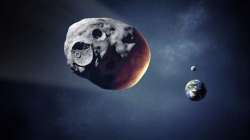Brace for a close encounter! Three-mile asteroid to whizz past Earth on September 1
Florence will be the largest Near-Earth Object (NEO) to whiz past the planet since NASA began tracking them some 20 years ago

Planet Earth is set for a close shave next month when a rock measuring 4.4 km (2.7 miles) will pass by our planet next month. According to US space agency NASA, Asteroid Florence, a large near-Earth asteroid, will pass safely by Earth on September 1, 2017, at a distance of about 4.4 million miles, (7.0 million kilometers, or about 18 Earth-Moon distances).
There are several reasons why this event will be special. Florence is among the largest near-Earth asteroids that are several miles is size.
While asteroids fly past Earth on a regular basis, they're usually only a few meters wide. However, Florence will be the largest Near-Earth Object (NEO) to whiz past the planet since NASA began tracking them some 20 years ago.
“While many known asteroids have passed by closer to Earth than Florence will on September 1, all of those were estimated to be smaller,” said Paul Chodas, manager of NASA’s Center for Near-Earth Object Studies (CNEOS) at the agency's Jet Propulsion Laboratory in Pasadena, California.
“Florence is the largest asteroid to pass by our planet this close since the NASA program to detect and track near-Earth asteroids began.”
Since 1998, when NASA first began tracking potentially hazardous objects, it has spotted over 16,000 NEOs. However, the 2017 encounter is the closest by this asteroid since 1890 and the closest it will ever be until after 2500.
Florence will brighten to ninth magnitude in late August and early September, when it will be visible in small telescopes for several nights as it moves through the constellations Piscis Austrinus, Capricornus, Aquarius and Delphinus, NASA said.
This relatively close encounter provides an opportunity for scientists to study this asteroid up close, said the space agency.
“Florence is expected to be an excellent target for ground-based radar observations. Radar imaging is planned at NASA's Goldstone Solar System Radar in California and at the National Science Foundation's Arecibo Observatory in Puerto Rico. The resulting radar images will show the real size of Florence and also could reveal surface details as small as about 30 feet (10 meters),” it said.
Asteroid Florence was discovered by Schelte "Bobby" Bus at Siding Spring Observatory in Australia in March 1981. It is named in honor of Florence Nightingale (1820-1910), the founder of modern nursing.
Radar imaging is planned at NASA's Goldstone Solar System Radar in California and at the National Science Foundation's Arecibo Observatory in Puerto Rico.
When these small, natural remnants of the formation of the solar system pass relatively close to Earth, deep space radar is a powerful technique for studying their sizes, shapes, rotation, surface features and roughness, and for more precise determination of their orbital path.
While the planet is safe from any possibility of a collision, it is set for a closer shave in October when asteroid 2012 TC4 brushes past within 50,100 km (31,130 mi) or just 0.13 lunar distances.
The relief though is that this rock is much smaller, measuring only 15 m (49 ft) across.
(With agencies)
